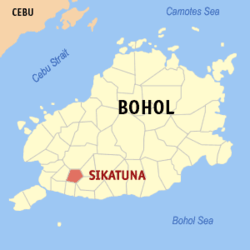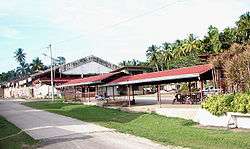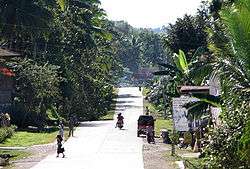Sikatuna, Bohol
| Sikatuna | ||
|---|---|---|
| Municipality | ||
|
Sikatuna, Bohol | ||
| ||
 Map of Bohol with Sikatuna highlighted | ||
.svg.png) Sikatuna Location within the Philippines | ||
| Coordinates: 9°41′N 123°58′E / 9.68°N 123.97°ECoordinates: 9°41′N 123°58′E / 9.68°N 123.97°E | ||
| Country | Philippines | |
| Region | Central Visayas (Region VII) | |
| Province | Bohol | |
| District | 1st district of Bohol | |
| Established | 5 December 1917 | |
| Barangay | 10 (see § Barangays) | |
| Government [1] | ||
| • Type | Sangguniang Bayan | |
| • Mayor | Jose Ellorimo (LP) | |
| • Vice mayor | Julian Manigo | |
| • Town Council |
Members
| |
| • Representative | Rene Relampagos | |
| Area[2] | ||
| • Total | 38.22 km2 (14.76 sq mi) | |
| • Land | 26.75 km2 (10.33 sq mi) | |
| Population (2015 census)[3] | ||
| • Total | 6,726 | |
| • Density | 180/km2 (460/sq mi) | |
| • Voter (2016)[4] | 4,647 | |
| Time zone | PST (UTC+8) | |
| ZIP code | 6338 | |
| IDD : area code | +63 (0)38 | |
| Income class | 5th class | |
| PSGC | 071241000 | |
| Website |
www | |
Sikatuna is a 5th municipal income class municipality in the province of Bohol, Philippines,[2] 17 kilometres (11 mi) from Tagbilaran. According to the 2015 census, it has a population of 6,726.[3] In the 2016 election, it had 4,647 registered voters.[4] It has a total area of 3,822 hectares (9,440 acres), making it the smallest municipality in Bohol. The town is named after Datu Sikatuna, the ancient chieftain of Bohol, although there is no evidence he lived in the area.
History
Sikatuna was formerly a part of the towns of Baclayon and Alburquerque. While part of Baclayon, Sikatuna was known as barrio Cambojod. Once Alburquerque became a town, Sikatuna was made a part of its new territory and given the name Cornago. Sikatuna became its own town in 1917. The ten barangays that now comprise Sikatuna were taken from three neighboring old municipalities: Alburquerque, Loboc, and Balilihan. In the original municipal ordinance converting barrio Cornago into a municipality, the municipal boundary was defined as barrio Cornago plus four northern barrios of Alburquerque: Libjo, Abucay Sur, Abucay Norte, and Can-agong. However, Senator Jose A. Clarin helped increase the territorial boundary by taking two barrios from Loboc: Cambuac Sur and Cambuac Norte; and two barrios from Balilihan: Badiang and Bahay-bahay. Cornago was divided into Poblacion I and Poblacion II.
World War II
During the Japanese occupation of the Philippines, Japanese forces established a garrison at the municipal building and installed a puppet mayor. During this time, Sikatuna became a haven for evacuees, both from neighboring towns and from nearby Cebu. The most famous evacuee was Don Mariano Jesus Cuenco who, after the war, became Senator and later, Secretary of Public Works. In 1945, Sikatuna was entered by Philippine Commonwealth Army soldiers and Boholano guerrillas fought against the Japanese Imperial forces during the Second Battle of Bohol.
Barangays
Sikatuna comprises 10 barangays. Of these, only Poblacion I is classified as urban and the rest are rural.
| PSGC | Barangay | Population | ±% p.a. | Area[2] | PD 2015 | |||||
|---|---|---|---|---|---|---|---|---|---|---|
| 2015[3] | 2010[5] | ha | acre | /km2 | /sq mi | |||||
| 071241001 | Abucay Norte | 7.7% | 516 | 460 | +2.21% | 149 | 368 | 350 | 900 | |
| 071241002 | Abucay Sur | 9.9% | 666 | 582 | +2.60% | 194 | 479 | 340 | 890 | |
| 071241003 | Badiang | 8.9% | 599 | 605 | −0.19% | 409 | 1,011 | 150 | 380 | |
| 071241004 | Bahaybahay | 6.4% | 430 | 396 | +1.58% | 290 | 717 | 150 | 380 | |
| 071241005 | Cambuac Norte | 10.2% | 688 | 632 | +1.63% | 421 | 1,040 | 160 | 420 | |
| 071241006 | Cambuac Sur | 17.5% | 1,174 | 1,173 | +0.02% | 297 | 734 | 400 | 1,000 | |
| 071241007 | Canagong | 9.4% | 635 | 689 | −1.54% | 299 | 739 | 210 | 550 | |
| 071241008 | Libjo | 7.1% | 480 | 466 | +0.57% | 310 | 766 | 150 | 400 | |
| 071241009 | Poblacion I | 17.0% | 1,141 | 1,009 | +2.37% | 202 | 499 | 560 | 1,500 | |
| 071241010 | Poblacion II | 5.9% | 397 | 368 | +1.45% | 251 | 620 | 160 | 410 | |
| Total | 6,726 | 6,380 | +1.01% | 3,822 | 9,444 | 180 | 460 | |||
| |
Demographics
| Population census of Sikatuna | |||||||||||||||||||||||||
|---|---|---|---|---|---|---|---|---|---|---|---|---|---|---|---|---|---|---|---|---|---|---|---|---|---|
|
| ||||||||||||||||||||||||
| Source: Philippine Statistics Office[3][5][6] | |||||||||||||||||||||||||
In the 2016 election, it had 4,647 registered voters, meaning that 69% of the population are aged 18 and over.[4]

References
- ↑ "Municipality". Quezon City, Philippines: Department of the Interior and Local Government. Retrieved 31 May 2013.
- 1 2 3 "Municipal: Sikatuna, Bohol". PSGC Interactive. Quezon City, Philippines: Philippine Statistics Authority. Retrieved 8 January 2016.
- 1 2 3 4 "Region VII (CENTRAL VISAYAS)". Census of Population (2015): Total Population by Province, City, Municipality and Barangay (Report). PSA. Retrieved 20 June 2016.
- 1 2 3 "2016 National and Local Elections Statistics". Commission on Elections. 2016.
- 1 2 "Region VII (CENTRAL VISAYAS)". Census of Population and Housing (2010): Total Population by Province, City, Municipality and Barangay (Report). NSO. Retrieved 29 June 2016.
- ↑ "Region VII (CENTRAL VISAYAS)". Census of Population (1995, 2000 and 2007): Total Population by Province, City and Municipality (Report). NSO. Archived from the original on 24 June 2011.
External links
 |
Balilihan | Sevilla |  | |
| Corella | |
|||
| ||||
| | ||||
| Alburquerque | Loboc |


